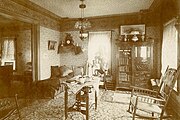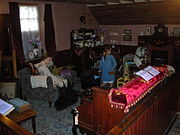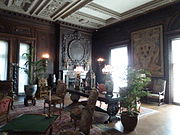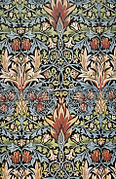Victorian decorative arts
This article has multiple issues. Please help improve it or discuss these issues on the talk page. (Learn how and when to remove these template messages)
|

Victorian decorative arts refers to the style of
Architecture
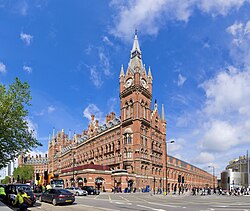
Victorian architecture is a series of architectural revival styles in the mid-to-late 19th century. Victorian refers to the reign of Queen Victoria (1837–1901), called the Victorian era, during which period the styles known as Victorian were used in construction. However, many elements of what is typically termed "Victorian" architecture did not become popular until later in Victoria's reign, roughly from 1850 and later. The styles often included interpretations and eclectic revivals of historic styles (see Historicism). The name represents the British and French custom of naming architectural styles for a reigning monarch. Within this naming and classification scheme, it followed Georgian architecture and later Regency architecture and was succeeded by Edwardian architecture.
Although Victoria did not reign over the United States, the term is often used for American styles and buildings from the same period, as well as those from the British Empire.Interior decoration and design
The parlour was the most important room in a home and was the showcase for the homeowners where guests were entertained. The dining room was the second-most important room in the house. The sideboard was most often the focal point, which attracts visitor’s eyes immediately when they go into a room or space,[1] of the dining room and very ornately decorated.
Old interiors
-
Dining room of the Theodore Roosevelt Sr. townhouse, New York City (1873, demolished).
-
Victorian style dining room, USA,
early 1900s. -
Victorian style parlor, USA, early 1900s
-
Room with Victorian design, early 1900s
-
Parlor in a New York House from the 1850s.
-
The parlor of the Whittemore House 1526 New Hampshire Avenue, Dupont Circle, Washington, D.C
Preserved interiors, private spaces
-
1890s Bedroom, James A. Garfield National Historic Site
-
Victorian bedroom exhibition, Dalgarven Mill, Ayrshire
-
Victorian kitchen, Dalgarven Mill, Ayrshire
-
Victorian kitchen, Dalgarven
Preserved interiors, public spaces
-
A Victorian sittingroom
-
Vanderbilt Mansion, living room
-
1879, parlor of Emlen Physick Estate, 1048 Washington Street, New Jersey
-
Lanhydrock House, drawing room
-
Dunedin Club, interior, billiard room
-
The Commandant drawing room, Port Arthur, Tasmania
-
Workhouse schoolroom
Walls and ceilings
The choice of paint color on the walls in Victorian homes was said to be based on the use of the room. Hallways that were in the entry hall and the stair halls were painted a somber gray so as not to compete with the surrounding rooms. Most people marbleized the walls or the woodwork. Also on walls it was common to score into wet plaster to make it resemble blocks of stone. Finishes that were either
Wallpaper
Wallpaper and wallcoverings became accessible for increasing numbers of householders with their wide range of designs and varying costs. This was due to the introduction of mass production techniques and, in England, the repeal in 1836 of the Wallpaper tax introduced in 1712.
-
Artichoke wallpaper, by John Henry Dearle for Morris & Co., circa 1897 (Victoria and Albert Museum).
-
Acanthus wallpaper, 1875
-
Snakeshead printed textile, 1876
-
Peacock and Dragon woven wool furnishing fabric, 1878
-
Design for Windrush printed textile, 1881–83
-
Detail of Woodpecker tapestry, 1885
Furniture

There was not one dominant style of furniture in the Victorian period. Designers rather used and modified many styles taken from various time periods in history like
-
Albert Chevallier Tayler The Grey Drawing Room
-
Albert Chevallier Tayler The Quiet Hour
-
Breakfast by Albert Chevallier Tayler 1909
-
Christmas tree decoration by Marcel Rieder (1862-1942)
Oscar Wilde's aesthetic of Victorian decoration
Chief among the literary practitioners of decorative aestheticism was Oscar Wilde, who advocated Victorian decorative individualism in speech, fiction, and essay-form.[2] Wilde’s notion of cultural enlightenment through visual cues echoes that of Alexander von Humboldt[3] who maintained that imagination was not the Romantic figment of scarcity and mystery but rather something anyone could begin to develop with other methods, including organic elements in pteridomania.[4]
By changing one’s immediate dwelling quarters, one changed one’s mind as well;[5] Wilde believed that the way forward in cosmopolitanism began with as a means eclipse the societally mundane, and that such guidance would be found not in books or classrooms, but through a lived Platonic epistemology.[6] An aesthetic shift in the home’s Victorian decorative arts reached its highest outcome in the literal transformation of the individual into cosmopolitan, as Wilde was regarded and noted among others in his tour of America.[7]
For Wilde, however, the inner meaning of Victorian decorative arts is fourfold: one must first reconstruct one’s inside so as to grasp what is outside in terms of both living quarters and mind, whilst hearkening back to von Humboldt on the way to Plato so as to be immersed in contemporaneous cosmopolitanism,[8] thereby in the ideal state becoming oneself admirably aesthetical.
See also
- Victorian fashion – Fashions and trends in British culture during the Victorian era
- Victoriana – items from the Victorian period
- Eastlake movement – Architectural movement
- French polish – Wood finishing technique
- Neo-Victorian – Aesthetic movement
- Pteridomania – Popular craze in late nineteenth-century United Kingdom
- Staffordshire dog figurine
- Hand cooler – egg-shaped item originally made of porcelain, marble, glass or crystal, cooled and carried in the hand
- Charles Eastlake – English architect and designer
- Augustus Pugin – English architect and designer
- William Morris wallpaper designs – Interior design
References
- ^ Nguyen Hoang, Viet. "Focal Point In Interior Design". Stunninteriors.
- ^ van der Plaat (2015), pp. 9–10.
- ^ van der Plaat (2015), pp. 1–2, 12.
- ^ Flanders (2002), pp. 200–202.
- ^ van der Plaat (2015), pp. 11–14.
- ^ van der Plaat (2015), pp. 11–16.
- ^ Blanchard (1995), pp. 39–45.
- ^ Monsman (2002), pp. 26–29.
Works cited
- Blanchard, Mary W. (1995). "Boundaries and the Victorian Body: Aesthetic Fashion in Gilded Age America". The American Historical Review. 100 (1): 39–45. JSTOR 2167982.
- Flanders, Judith (2002). Inside the Victorian Home. New York: W.W. Norton & Co. pp. 200–202.
- Monsman, Gerald (2002). "The Platonic Eros of Walter Pater and Oscar Wilde: Love's Reflected Image in the 1890s". English Literature in Transition. 45 (1): 26–29. ISSN 1559-2715.
- van der Plaat, Deborah (2015). "Visualising the Critical: Artistic Convention and Eclecticism in Oscar Wilde's Writings on the Decorative Arts". Australasian Journal of Victorian Studies. 19 (1): 5–19. ISSN 1327-8746.
External links
This article's use of external links may not follow Wikipedia's policies or guidelines. (August 2022) |
- Victorian Furniture
- Victorian Room Virtual Tour
- Victorian Design (victorianweb.org) including ceramics, furniture, glass, jewelry, metalwork, and textiles.
- Early Victorian Furniture History in England
- Interior decoration and design
- Late Victorian Era Furniture History in England
- Victorian Bookmarks
- Mostly-Victorian.com - Arts, crafts and interior design articles from Victorian periodicals.
- "Victorian Furniture Styles". Furniture. Victoria and Albert Museum. Archived from the original on 2010-11-19. Retrieved 2011-04-03.
- The history of wallcoverings and wallpaper
- Interior design: Victorian - National Trust




